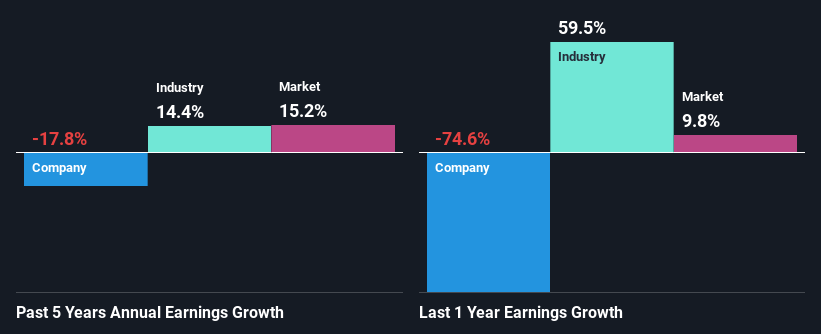- Saudi Arabia
- /
- Metals and Mining
- /
- SASE:9513
Is The Market Rewarding Watani Iron Steel Company (TADAWUL:9513) With A Negative Sentiment As A Result Of Its Mixed Fundamentals?

With its stock down 22% over the past three months, it is easy to disregard Watani Iron Steel (TADAWUL:9513). We, however decided to study the company's financials to determine if they have got anything to do with the price decline. Fundamentals usually dictate market outcomes so it makes sense to study the company's financials. Particularly, we will be paying attention to Watani Iron Steel's ROE today.
Return on equity or ROE is a key measure used to assess how efficiently a company's management is utilizing the company's capital. Simply put, it is used to assess the profitability of a company in relation to its equity capital.
See our latest analysis for Watani Iron Steel
How To Calculate Return On Equity?
Return on equity can be calculated by using the formula:
Return on Equity = Net Profit (from continuing operations) ÷ Shareholders' Equity
So, based on the above formula, the ROE for Watani Iron Steel is:
2.6% = ر.س6.4m ÷ ر.س246m (Based on the trailing twelve months to June 2024).
The 'return' is the profit over the last twelve months. Another way to think of that is that for every SAR1 worth of equity, the company was able to earn SAR0.03 in profit.
What Has ROE Got To Do With Earnings Growth?
We have already established that ROE serves as an efficient profit-generating gauge for a company's future earnings. We now need to evaluate how much profit the company reinvests or "retains" for future growth which then gives us an idea about the growth potential of the company. Assuming everything else remains unchanged, the higher the ROE and profit retention, the higher the growth rate of a company compared to companies that don't necessarily bear these characteristics.
Watani Iron Steel's Earnings Growth And 2.6% ROE
As you can see, Watani Iron Steel's ROE looks pretty weak. Even compared to the average industry ROE of 6.7%, the company's ROE is quite dismal. Given the circumstances, the significant decline in net income by 18% seen by Watani Iron Steel over the last five years is not surprising. We believe that there also might be other aspects that are negatively influencing the company's earnings prospects. Such as - low earnings retention or poor allocation of capital.
So, as a next step, we compared Watani Iron Steel's performance against the industry and were disappointed to discover that while the company has been shrinking its earnings, the industry has been growing its earnings at a rate of 14% over the last few years.

Earnings growth is a huge factor in stock valuation. The investor should try to establish if the expected growth or decline in earnings, whichever the case may be, is priced in. By doing so, they will have an idea if the stock is headed into clear blue waters or if swampy waters await. Is 9513 fairly valued? This infographic on the company's intrinsic value has everything you need to know.
Is Watani Iron Steel Using Its Retained Earnings Effectively?
Because Watani Iron Steel doesn't pay any regular dividends, we infer that it is retaining all of its profits, which is rather perplexing when you consider the fact that there is no earnings growth to show for it. So there might be other factors at play here which could potentially be hampering growth. For example, the business has faced some headwinds.
Conclusion
Overall, we have mixed feelings about Watani Iron Steel. While the company does have a high rate of profit retention, its low rate of return is probably hampering its earnings growth. Wrapping up, we would proceed with caution with this company and one way of doing that would be to look at the risk profile of the business. To know the 3 risks we have identified for Watani Iron Steel visit our risks dashboard for free.
Valuation is complex, but we're here to simplify it.
Discover if Watani Iron Steel might be undervalued or overvalued with our detailed analysis, featuring fair value estimates, potential risks, dividends, insider trades, and its financial condition.
Access Free AnalysisHave feedback on this article? Concerned about the content? Get in touch with us directly. Alternatively, email editorial-team (at) simplywallst.com.
This article by Simply Wall St is general in nature. We provide commentary based on historical data and analyst forecasts only using an unbiased methodology and our articles are not intended to be financial advice. It does not constitute a recommendation to buy or sell any stock, and does not take account of your objectives, or your financial situation. We aim to bring you long-term focused analysis driven by fundamental data. Note that our analysis may not factor in the latest price-sensitive company announcements or qualitative material. Simply Wall St has no position in any stocks mentioned.
About SASE:9513
Watani Iron Steel
Engages in the manufacturing and sale of rebar steel and billets for construction sector in the Kingdom of Saudi Arabia.
Adequate balance sheet low.


